#Ecclesia de Eucharistia
Text
La Chiesa riparta dall’Eucaristia, la lezione di Giovanni Paolo II
In un momento così grave per la Chiesa, attaccata anche dal suo interno, è di grande aiuto riprendere l’insegnamento di san Giovanni Paolo II nell’Ecclesia de Eucharistia. Perché nell’adorazione di Gesù Eucaristico c’è il rimedio a tutti i mali.
Continue reading Untitled
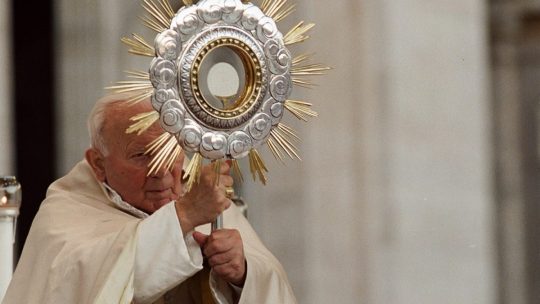
View On WordPress
0 notes
Text
Misterium fidei
Jan Paweł II powiedział kiedyś do włoskiej młodzieży: Eucharystia jest tajemnicą mojego dnia. Nadaje siłę i sens wszystkim moim działaniom w służbie Kościołowi i całemu światu… Widzieliśmy to wszyscy. To był Papież Eucharystii. I był to Papież Miłosierdzia. I te dwie encykliki wyznaczają jego pontyfikat Dives in Misericordia napisał na początku a O Eucharystii na końcu jako ostatnią. Ona jest tak…
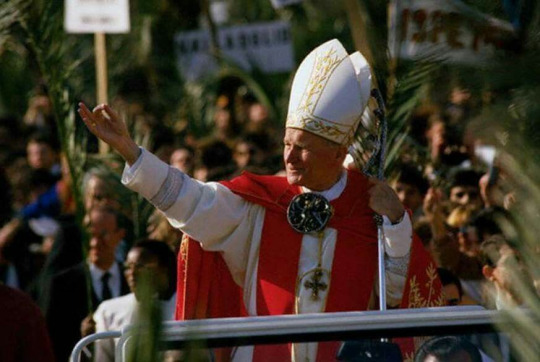
View On WordPress
0 notes
Text
Pregunta
Querido padre Angelo,
antes que nada quiero agradecerle que me haya inscripto en la Confraternidad del Santo Rosario al comienzo de noviembre, porque he podido comprobar personalmente los beneficios espirituales y materiales que se obtienen. Creo que la comunitaria, aun en esta forma tan peculiar, sea la dimensión más auténtica de una oración como la del Rosario. Siento que mis rosarios son más amplios, completos, profundos. Entre otras cosas es hermoso saber que se está en unidad espiritual con tantos hermanos que combaten la buena batalla, dándose ánimo y gracia mutua en vistas del fin último, que es la salvación de nuestras almas y de las de todos nuestros hermanos dispersos por la tierra.
Tengo una pregunta para usted. Hace algunos domingos atrás en mi parroquia, durante la misa, esperaba mi turno para confesarme. Había cola, mientras esperaba, la misa estaba por terminar y comenzó la distribución de la comunión. Yo estaba en pecado mortal y no podía comulgar. Una vez en el confesionario, el sacerdote me dijo que habría podido tomar la comunión si estaba esperando confesarme. Yo le respondí que sabía que era buena norma no hacerla nunca sin haberse confesado antes. Después de una breve (amigable) discusión, yo concluí que habría seguido ateniéndome a esa buena regla: en caso de pecado mortal, siempre antes la confesión y luego la comunión. ¿Qué piensa usted de esto?¿El que espera confesarse en el arco de pocos minutos, puede comulgar? A mí me parece que no, porque pienso que la confesión extirpe realmente el veneno del pecado en el alma, por tanto comulgar con la sola intención de confesarse, aunque se realice efectivamente después de diez minutos, se cumple igualmente el sacrilegio de recibir a Cristo en un alma sucia, por más arrepentida y bien dispuesta que esté. No se trata de creer o no en la efectiva existencia de estas realidades espirituales. De otra manera daría igual abolir la confesión y hacerse a propio gusto un arrepentimiento autónomo, lo cual es obviamente absurdo.
Un afectuoso saludo,
Paolo
Respuesta del sacerdote
Querido Paolo,
1. hiciste bien en decir al sacerdote que te habrías atenido a “esa buena regla” de anteponer la confesión a la Santa Comunión, en caso te hallaras en pecado mortal. Sin embargo, no se trata solamente de una buena regla, sino de un deber.
2. De hecho te dabas cuenta de que tu alma estaba sucia, como dijiste, y habría sido un insulto recibir la Santa Comunión en ese estado.
La Sagrada Escritura dice que: La Sabiduría no entra en un alma que hace el mal ni habita en un cuerpo sometido al pecado (Sab 1, 4).
3. La absolución sacramental cambia instantáneamente el estado del alma. Le saca en seguida “el veneno del pecado” de la misma manera en que Jesús sanaba a los enfermos y expulsaba a los demonios.
4. Por eso san Juan Pablo II después de haber recordado que el Catecismo de la Iglesia Católica establece que “quien tiene conciencia de estar en pecado grave debe recibir el sacramento de la Reconciliación antes de acercarse a comulgar” (CIC 1385) afirma: “Deseo, por tanto, reiterar que está vigente, y lo estará siempre en la Iglesia, la norma con la cual el Concilio de Trento ha concretado la severa exhortación del apóstol Pablo, al afirmar que, para recibir dignamente la Eucaristía, « debe preceder la confesión de los pecados, cuando uno es consciente de pecado mortal »”(Ecclesia de Eucharistia 36).
5. La expresión “está vigente, y lo estará siempre” da a entender que no se trata simplemente de una disciplina de la Iglesia, sino de una exigencia que emerge no solamente del sentido común, sino de la Sagrada Escritura.
En efecto en la primera carta a los Corintios se puede leer: “Que cada uno se examine a sí mismo antes de comer este pan y beber esta copa” (1 Cor 11, 28).
Es evidente que ese se examine y ese antes significa que debe hacerse lo necesario para comulgar dignamente.
6. Por eso San Agustín rechaza fehacientemente que se pueda comulgar no obstante exista el propósito de confesar e
l pecado grave.
Recuerda la práctica en esa época vigente, que no sólo no se podía comulgar antes de haberse reconciliado con la Iglesia, sino que no se podía ser reconciliados - es decir, recibir la absolución- si antes no se había cumplido con la Penitencia.
Y concluía: “Entonces, ¿se dijo inútilmente: Lo que desatéis en la tierra será desatado en el cielo? Entonces, ¿se confiaron si valor alguno las llaves a la Iglesia? ¿Esquivo el Evangelio y las palabras de Cristo?” (Sermón 392, 3).
7. Respondiendo de este modo al confesor demostraste que posees ese “sensus fidei” del pueblo cristiano en el que no hay error, como garantiza el Concilio Vaticano II: “La totalidad de los fieles, que tienen la unción del Santo (cf. 1 Jn 2, 20 y 27), no puede equivocarse cuando cree, y esta prerrogativa peculiar suya la manifiesta mediante el sentido sobrenatural de la fe de todo el pueblo” (Lumen Gentium 12).
Sigue comportándote así.
8. Quiero agradecerte además por el testimonio que has querido compartir acerca de la eficacia del santo rosario rezado en comunión espiritual con la Confraternidad del SS Rosario.
Sí, vale, y muchísimo, rezarlo individualmente.
Pero, al pertenecer a la confraternidad del SS Rosario, hay una comunión profunda con la oración y los méritos de otros muchos que unidos con un mismo vínculo se enriquecen los unos de los méritos de los otros.
Te deseo una Santa Navidad rica de gracia y de paz.
Te recuerdo al Señor y te bendigo.
Padre Angelo
0 notes
Text
Alla scuola di Padre Pio per amare l’Eucaristia
Alla scuola di Padre Pio per amare l’Eucaristia
Vi sono luoghi in cui si registra un quasi completo abbandono della retta fede e del degno culto alla divina Eucaristia. Comprensioni riduttive del Mistero eucaristico generano abusi che ne oscurano ulteriormente la grandezza. Ma il “dono” è troppo grande per poter tollerare diminuzioni. Dobbiamo tornare a contemplarlo con gli occhi della Fede cattolica e dei Santi.
(more…)
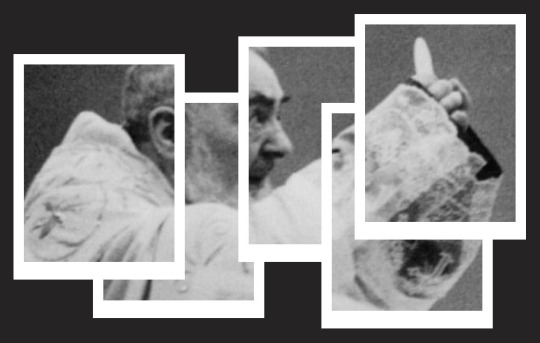
View On WordPress
0 notes
Quote
Like the woman who anointed Jesus in Bethany, the Church has feared no “extravagance”, devoting the best of her resources to expressing her wonder and adoration before the unsurpassable gift of the Eucharist. No less than the first disciples charged with preparing the “large upper room”, she has felt the need, down the centuries and in her encounters with different cultures, to celebrate the Eucharist in a setting worthy of so great a mystery.
Pope John Paul II, Ecclesia de Eucharistia, no. 48.
9 notes
·
View notes
Text
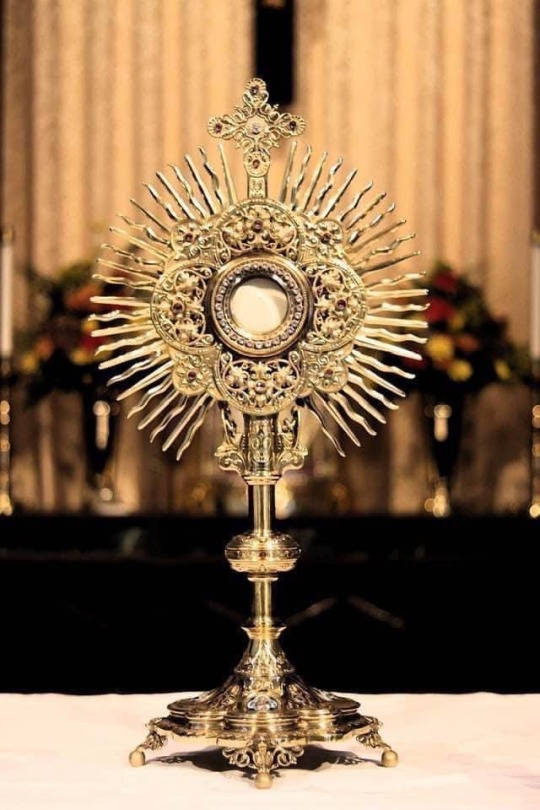
"'Going into the house, they saw the child with Mary His mother, and they fell down and worshipped Him' (Matthew 2:11). Dear friends, this is not a distant story that took place long ago. It is with us now. Here in the sacred Host He is present before us and in our midst. As at that time, so now He is mysteriously veiled in a sacred silence; as at that time, it is here that the true face of God is revealed. For us he became a grain of wheat that falls on the ground and dies and bears fruit until the end of the world (cf. John 12:24). He is present now as He was then in Bethlehem. He invites us to that inner pilgrimage which is called adoration. Let us set off on this pilgrimage of the spirit and let us ask Him to be our guide" (Benedict XVI)
When we contemplate the Eucharistic face of Christ, we see His suffering, His humility, His patience, the unutterable beauty and glory of His resurrected state, His majesty as He sits at the right hand of the Father in heaven. We know that the Lord we receive in Holy Communion and whom we adore afterwards is the glorified Christ: "The flesh of the Son of Man, given as food, is His body in its glorious state after the resurrection (Ecclesia de Eucharistia).
Jesus reveals His Eucharistic face to us as we grow in His grace and love. It will take our life-time and the hereafter to contemplate the wonder of His humanity and divinity, that boundless love which caused Him to sacrifice Himself for our redemption.
Our hope is to see and enjoy Him, face to face, in heaven, to be with Him for all eternity. But, here and now, in our pilgrim state on earth, we must be content to see that face in the Eucharistic Species, adoring Him daily in order to grow in holiness.
10 notes
·
View notes
Text
Holy Land Retrospective - Day 6
Reminder: clicking on the link for each photo (links are all in red text) will take you to the Flickr page where you can see the photo in larger sizes.
Start with DAY 1, or catch up with DAY 2, or DAY 3, or DAY 4, or DAY 5. Or just read on!
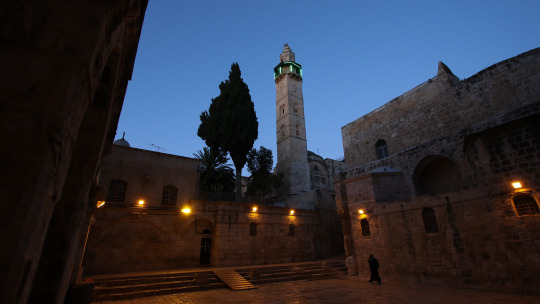
PHOTO 26: It was Saturday; the day of the Jewish Shabbat, a holy day when the highlight of the whole pilgrimage took place: we would have Mass at the Empty Tomb of Christ, in the church of the Holy Sepulchre. Appropriately, we made our way to the church in silence, processing through deserted city, and the church, too, was nearly empty when we arrived. After all, it was shortly after 4 a.m. (!) when we entered the city through Herod’s Gate and walked through the silent Muslim Quarter to the Franciscan monastery.
Moving some 250 people in silence through the uneven streets of an ancient city, before daybreak, is an impressive feat! But this silence and secrecy was entirely fitting. For the Gospels, too, are silent about what happened on the Saturday, the day of the Passover, after Jesus was crucified. St John says the following about the Friday on which Jesus died, the “day of Preparation” but concerning the Sabbath, nothing is reported – it is only alluded to:
“Since it was the day of Preparation, in order to prevent the bodies from remaining on the cross on the sabbath (for that sabbath was a high day), the Jews asked Pilate that their legs might be broken, and that they might be taken away... But one of the soldiers pierced his side with a spear, and at once there came out blood and water... After this Joseph of Arimathe'a, who was a disciple of Jesus, but secretly, for fear of the Jews, asked Pilate that he might take away the body of Jesus, and Pilate gave him leave. So he came and took away his body. Nicodemus also, who had at first come to him by night, came bringing a mixture of myrrh and aloes, about a hundred pounds' weight. They took the body of Jesus, and bound it in linen cloths with the spices, as is the burial custom of the Jews. Now in the place where he was crucified there was a garden, and in the garden a new tomb where no one had ever been laid. So because of the Jewish day of Preparation, as the tomb was close at hand, they laid Jesus there.” (Jn 19:31, 34, 38-42)
From the Franciscan Monastery of the Flagellation, we began our quiet journey on the Via Dolorosa, sleepy but alert, praying the Stations of the Cross as best as we could. Somewhere in the crowd, Jim Caviezel walked with us, as together with him we walked the path of Jesus through the streets of Jerusalem.
At around 5:30 a.m. we prayed the last three stations of the Cross in the courtyard in front of the church of the Holy Sepulchre; in the distance, a cock crowed.
This photo was taken shortly after everyone had entered the church, looking back towards the way we had come; the minaret of the mosque of Omar looms overhead. For many of our group, it was their first time visiting Calvary and the Empty Tomb so I remained outside and I savoured the cool air of the morning; and soaked in the silence of the holy courtyard, traversed only by a cat or a monk; and I observed the colour of the sky change as the light of the new day came. Dawn at the Holy Sepulchre on an Easter Saturday: what a blessed moment!
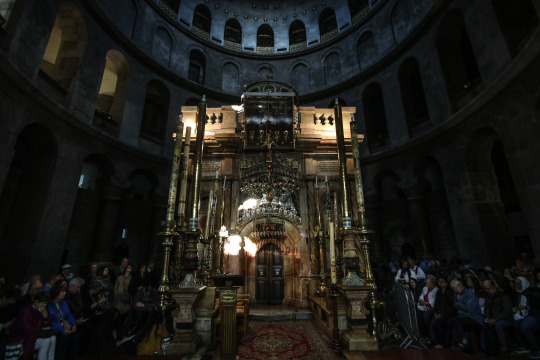
PHOTO 27: We had a good hour and a half before the time allocated to us for Mass: time to explore, time to pray and reflect, time for Confession and spiritual preparation for Holy Mass. Ahead of us, saying Mass inside the Empty Tomb with a small group of pilgrims, was the Bishop of a French diocese, hence the doors are closed. During this time, one of our group took photos of these closed doors and she came and showed me the photos. One of them had the clear figure of a man robed in a white Jewish prayer shawl standing in the doorway, even though none of us had seen the doors even open! Take a look here and see what you think!
"I saw the risen Lord appearing to His Blessed Mother on Mount Calvary. He was transcendently beautiful and glorious, His manner full of earnestness. His garment, which was like a white mantle thrown about His limbs, floated in the breeze behind Him as He walked. It glistened blue and white, like smoke curling in the sunshine.” - Blessed Anne Catherine Emmerich’s vision of the Risen Lord.
The photo above was taken very shortly before we went into the sacristy to prepare for Mass. I had been watching the sunlight of the new day penetrate the darkness of the Holy Sepulchre church. The rays of light enter through the smaller dome of the ‘Catholicon’ (the Greek Orthodox sanctuary in the centre of the building), and then it strikes the little onion dome and cross of the ‘Aedicule’, which is this structure that envelopes and protects the Empty Tomb itself. As the sun ascends in the sky, the rays of light then travel downwards until it reaches the doors of the Aedicule, and penetrate into the Empty Tomb.
An hour after this photo was taken, I was standing inside the Aedicule, concelebrating the Holy Mass with my brother priests, standing around the very spot where the angel of the Resurrection had hailed the holy women that first Easter morning. And then, stooping to go into the Empty Tomb itself, I received the Eucharistic Body and Blood of the Risen Christ that was lying on the Altar, on top of the stone where Jesus had been laid and from which he had risen from the dead, alleluia!
This single moment, this sun-lit morning, all we had experienced so far on the 4th of May 2019, was probably one of the most unforgettable and spiritually intense moments of my whole life.
“Do not be afraid... He is not here; for he has risen, as he said. Come, see the place where he lay. Then go quickly and tell his disciples that he has risen from the dead”. (Mt 28:5-7)
However, in every Mass, we encounter the Risen Lord, and we are then sent forth wherever we may be, as though from this Empty Tomb in Jerusalem, to quickly announce the Good News: Χριστός Ανέστη! Surrexit Dominus vere! Christ is risen, Alleluia, alleluia, alleluia!
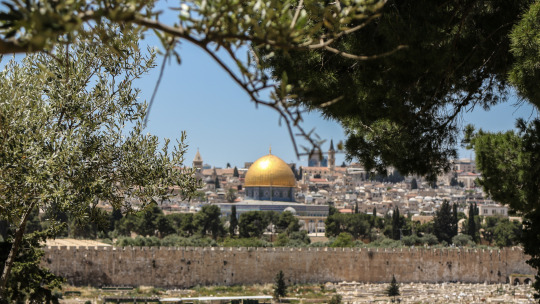
PHOTO 28: The focus of this photo is the olive tree, for we are on the Mount of Olives, looking towards the Holy City with the iconic Dome of the Rock, the Muslim shrine built on the very site where the Temple of Jerusalem once stood until the Romans destroyed it, as Christ prophesied, in 70 AD.
After Mass in the Holy Sepulchre, and after breakfast, we went to the top of the Mount of Olives to take in the view of the city, and then we descended the hill, waving palm branches and singing ‘Hosannas’ as we went; in a few hours we had gone from Easter morning to Palm Sunday! We made our way to the little church of Dominus Flevit where Jesus had beheld the city of Jerusalem, foretold of its destruction, and wept for its people.
Looking towards the city, one takes in its long and complicated and turbulent history; full of human strife and violence as the One the city had once hailed with ‘Hosannas’ was rejected, taken outside, and executed as a criminal. But, as St Paul says: “In him all the fulness of God was pleased to dwell, and through him to reconcile to himself all things, whether on earth or in heaven, making peace by the blood of his cross.” (Col 1:19-20)
In this photo, therefore, I wanted to show the city in its splendour and in its divided history, and also to take in the branches of the trees which the people had cut and waved to hail the coming Messiah. But above all, I wanted to focus on the olive branch, not just because it indicated our location, the Mount of Olives, but because it is a universally recognised emblem of peace.
“For the peace of Jerusalem pray:
"Peace be to your homes!
May peace reign in your walls,
in your palaces, peace!"” – Psalm 122:6-7
Agnus Dei, qui tollis peccata mundi: dona nobis pacem.
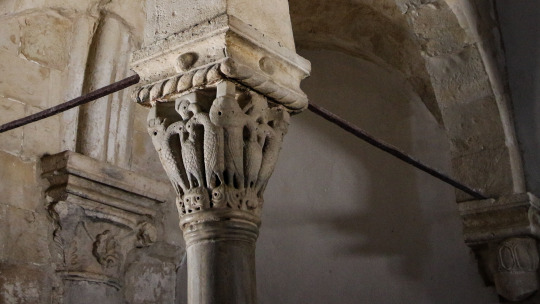
PHOTO 29: Continuing to mark Holy Week in one day, we went to Mount Sion after lunch, to the site of the Upper Room, the cenacle, where Jesus had celebrated the Passover with his disciples, instituting the sacraments of the Holy Eucharist and the Priesthood. In the same room, the Holy Spirit had came upon Our Lady and the disciples at Pentecost so that “out of Sion shall go forth the law, and the word of the LORD from Jerusalem" (Isa 2:3).
So, that Saturday afternoon we stood in a 14th-century structure built on various iterations of a church building that has stood here since the earliest days, although it is now sadly just an archeological space, a museum since beneath it is the tomb of King David, a holy shrine for the Jews and I suppose they did not want a church right above. But in the 5th-century, this holy place was called “Sion, Mother of all the Churches”.
This name is fitting since it is here that the Church was born. As Pope St John Paul II wrote shortly after visiting this place:
The Church, while pointing to Christ in the mystery of his passion, also reveals her own mystery: Ecclesia de Eucharistia. By the gift of the Holy Spirit at Pentecost the Church was born and set out upon the pathways of the world, yet a decisive moment in her taking shape was certainly the institution of the Eucharist in the Upper Room. Her foundation and wellspring is the whole Triduum paschale, but this is as it were gathered up, foreshadowed and “concentrated' for ever in the gift of the Eucharist. – Ecclesia de Eucharistia, 5.
The photo above is focussed on a carved stone capital from c.1335 that is part of the canopy over the platform where, perhaps, the altar would have once stood. This carving is interesting because of its Eucharistic symbolism. Over the past few days we have seen some other early Christian symbols such as the anchor, and the peacock. Here in the cenacle, in the place where Jesus gave us the Eucharist, we have the pelican. To be precise, two pelicans are shown plucking at the breast of the central pelican, and this symbol is known as the ‘Pelican in piety’. It was believed that pelicans would feed their own young with their own flesh and blood, and so this became an image of Christ feeding the Christian people: the Church receives its life from the Eucharist which is the sacrament of Christ’s Body and Blood; Ecclesia de Eucharistia.
So St Thomas Aquinas prayed in his hymn, Adoro Te devote:
Pie Pelicane, Jesu Domine, me immundum munda tuo Sanguine: cujus una stilla salvum facere totum mundum quit ab omni scelere.
Lord Jesus, Good Pelican, wash my filth and cleanse me with Your Blood, one drop of which can free the entire world of all its sins.
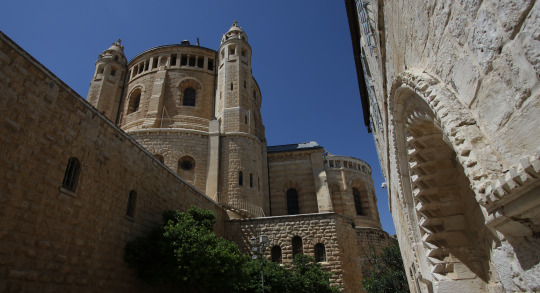
PHOTO 30: Standing at the doorway that leads up to the cenacle, we look back towards the tallest building in the area, built on the summit of Mount Sion. This is the Benedictine Abbey of the Dormition, which commemorates the fact that Our Lady, the “Daughter of Sion” fittingly ended her earthly life somewhere nearby on Mount Sion. Psalm 87, therefore, although it refers to the holy mountain of Sion has also long been regarded as alluding to Our Lady. For the Lord has preferred her to all others and has dwelt within her; like a city whose walls are never breached, so has she remained ever virgin yet is the abode of the great King:
On the holy mountain is his city
cherished by the Lord.
The Lord prefers the gates of Sion
to all Jacob's dwellings.
Of you are told glorious things,
O city of God! – Psalm 87:1-3
Saturdays, of course, are dedicated to Mary, so within the Dormition Abbey, we had gathered to sing glorious things concerning the Mother of God. As we headed back to the Old City of Jerusalem, passing by the Sion Gate, I stopped to marvel at the many beautiful roses that bloomed here. They were another fitting tribute to Our Lady, and a glorious end to our tour on Lady Day in the Holy Land.
Tomorrow: Reliving Easter Sunday at dawn by the Empty Tomb; Bethesda and Mary’s birthplace; Bar Mitzvah celebrations.
8 notes
·
View notes
Quote
The flesh of the Son of Man, given as food, is his body in its glorious state after the resurrection. With the Eucharist we digest, as it were, the 'secret' of the resurrection. For this reason Saint Ignatius of Antioch rightly defined the Eucharistic Bread as 'a medicine of immortality, an antidote to death'.
St. John Paul II, Ecclesia de Eucharistia, 18
68 notes
·
View notes
Photo

Why Our Hearts Burn for the Eucharist
Are you longing for the Holy Eucharist? You are not alone. Countless members of the Mystical Body across the world feel keenly the separation from Christ’s Real Presence. The joy of the Easter season this year is tinged with sorrow at the separation. We are living one of the great paradoxes of our faith, which is that joy and sorrow are often mingled together in this life. We trust, despite this sorrow, that this period of separation from Him in Holy Communion is an opportunity for us to grow in profound love for Him and the Church.
First, the disregard and guilting of those who miss the public celebration of the Mass and reception of Holy Communion needs to stop. The idea that telling our brothers and sisters in Christ to “suck it up” (pardon an expression from my military days) because people are dying is not only uncharitable it is to miss the fact that not being able to receive Our Lord in Holy Communion should cause us some level of pain and discomfort, not necessarily emotionally, but at least spiritually.
This is not an either/or situation. We can express our sorrow at being separated from the Mass while also being concerned about those who are sick and dying. Discussing that sorrow also does not mean a lack of resignation to God’s will. It is simply an expression that this period of exile is difficult, even if we know we must endure it and embrace it as a time of greater perfection in love. The example we can follow is that of Our Lady and St. John who endured the agony and sorrow of the Cross, but trusted in God’s ultimate plan. They still suffered tremendously, but they also surrendered in faith.
The Holy Eucharist is the very center of our Faith, which is why it is a great blow to the People of God in every age when they are barred from the public celebration of the Mass and the Sacraments. This does not mean these periods of suspension have not been necessary at times, but they are always a trial for the members of the Mystical Body. This makes perfect sense given the centrality of the Holy Eucharist in the life of the Church. St. John Paul II in the opening to his encyclical Ecclesia de Eucharistia states:
The Church draws her life from the Eucharist. This truth does not simply express a daily experience of faith, but recapitulates the heart of the mystery of the Church. In a variety of ways she joyfully experiences the constant fulfillment of the promise: “Lo, I am with you always, to the close of the age” (Mt 28:20), but in the Holy Eucharist, through the changing of bread and wine into the body and blood of the Lord, she rejoices in this presence with unique intensity. Ever since Pentecost, when the Church, the People of the New Covenant, began her pilgrim journey toward her heavenly homeland, the Divine Sacrament has continued to mark the passing of her days, filling them with confident hope.
The celebration of the Mass is the most tangible encounter we have with Christ on this side of eternity. It is why the separation causes immense sorrow. Even so, this period of exile is an opportunity to enter even more into the mystery of the Holy Eucharist through our prayer; to allow Christ to lead us to a greater love of Him through longing for His Real Presence. In order to do so, we cannot avoid this sorrow, nor can we dismiss it with a pragmatic wave of the hand. Instead, we must ask Him how we can love His Eucharistic Face with greater ardor and devotion.
To be sure, this is more difficult in our separation, but through prayer we can turn our gaze to Him in Sacred Scripture, prayer before the Tabernacle, spiritual communion, and studying the Church’s teachings on the Holy Eucharist and the Mass.
For the most holy Eucharist contains the Church’s entire spiritual wealth: Christ himself, our passover and living bread. Through his own flesh, now made living and life-giving by the Holy Spirit, he offers life to men. Consequently the gaze of the Church is constantly turned to her Lord, present in the Sacrament of the Altar, in which she discovers the manifestation of his boundless love.
St. John Paul II, Ecclesia de Eucharistia, 1.
We can join our gaze to the wider Church’s gaze throughout this present isolation and separation. The Holy Sacrifice of the Mass has not ceased. Our public participation has been temporarily suspended. We can still enter spiritually into the Mass as it is celebrated by our priests and bishops “from the rising of the sun to its setting” through our prayer. It is a time when we can seek union with God and the Church at the spiritual level: something that we risk ignoring when we are physically present at Mass.
The temptation to turn our gaze from His simply because the separation causes us periods of sorrow, agony, and tears may be great, but we must persevere. It may be that we experience aridity or no emotional response during this time. Our emotions are not a reliable indicator of our spiritual lives. No matter what we experience during this present exile, we must keep our gaze fixed on Christ’s loving gaze in union with the Church. If we stumble, then we must ask Him to help us get back up and to give us the grace we need to endure during this difficult period.
Throughout this particular Easter season, we are invited to enter into the totality of the paschal mystery from the passion and death of Our Lord to the Resurrection. We sense the presence of the Cross more keenly in this Easter season as countless people suffer in the current pandemic and the encroaching threat of economic turmoil. Seeking greater love of the Holy Eucharist will lead us deeper into the paschal mystery, the suffering the world is experiencing at present, and communion with the Mystical Body.
The Church was born of the paschal mystery. For this very reason the Eucharist, which is an outstanding way the sacrament of the paschal mystery, stands at the center of the Church’s life.
Ibid.
This period of exile is a time to be tried, tested, and purified through the refining fires of God’s love. Let’s seek to make Our Lord’s Real Presence the center of our lives so that when the joyous day comes when we can once more approach Him in Holy Communion, our hearts may be set ablaze with even greater love for Him.
BY: CONSTANCE T. HULL
1 note
·
View note
Quote
If we wish to rediscover in all its richness the profound relationship between the Church and the Eucharist, we cannot neglect Mary, Mother and model of the Church. In my Apostolic Letter Rosarium Virginis Mariae, I pointed to the Blessed Virgin Mary as our teacher in contemplating Christ's face, and among the mysteries of light I included the institution of the Eucharist.102 Mary can guide us towards this most holy sacrament, because she herself has a profound relationship with it.
At first glance, the Gospel is silent on this subject. The account of the institution of the Eucharist on the night of Holy Thursday makes no mention of Mary. Yet we know that she was present among the Apostles who prayed “with one accord” (cf. Acts 1:14) in the first community which gathered after the Ascension in expectation of Pentecost. Certainly Mary must have been present at the Eucharistic celebrations of the first generation of Christians, who were devoted to “the breaking of bread” (Acts 2:42).
But in addition to her sharing in the Eucharistic banquet, an indirect picture of Mary's relationship with the Eucharist can be had, beginning with her interior disposition. Mary is a “woman of the Eucharist” in her whole life. The Church, which looks to Mary as a model, is also called to imitate her in her relationship with this most holy mystery.
Pope John Paul II, Ecclesia de Eucharistia, no. 53.
0 notes
Text
L'Évangile du dimanche 22 août 2021

21e dimanche du T.O. - Jos 24,1-2a.15-17.18b /Ps 34(33),2-3.16-17.20-23 /Ep 5,21-32 /Jn 6,60-69Comme les Hébreux au Sinaï, les Israélites sont aujourd'hui appelés par Josué à choisir entre Yahvé et les dieux locaux. Leur réponse est nette : « Nous aussi nous voulons servir le Seigneur car c'est lui notre Dieu. » Jésus ne semble pas aujourd'hui rencontrer le même succès. Ses paroles se heurtent à l'incrédulité de beaucoup de ses auditeurs. Croire qu'il est le pain de Vie, lui, le fils de Joseph ? Jésus provoque une crise de purification de leur foi. Ils avaient rêvé d'un messie qui soit leur roi, et voilà que Jésus parle de se donner corps et âme jusque dans la mort. C'est un scandale ! Beaucoup le quittent ; les apôtres restent : « A qui irions-nous ? Tu as les paroles de la vie éternelle. » Et nous, vers qui irons-nous lorsque le doute sera sur notre chemin ? Accepterons-nous de poursuivre avec Jésus, d'assumer notre humanité jusqu'au bout, en nous inspirant de la sienne et en nous laissant transformer par son Esprit ?
Évangile de Jésus-Christ selon saint Jean 6,60-69
En ce temps-là, Jésus avait donné un enseignement dans la synagogue de Capharnaüm. Beaucoup de ses disciples, qui avaient entendu, déclarèrent : « Cette parole est rude ! Qui peut l'entendre ? »Jésus savait en lui-même que ses disciples récriminaient à son sujet. Il leur dit : « Cela vous scandalise ?Et quand vous verrez le Fils de l'homme monter là où il était auparavant ! …C'est l'esprit qui fait vivre, la chair n'est capable de rien. Les paroles que je vous ai dites sont esprit et elles sont vie.Mais il y en a parmi vous qui ne croient pas. » Jésus savait en effet depuis le commencement quels étaient ceux qui ne croyaient pas, et qui était celui qui le livrerait.Il ajouta : « Voilà pourquoi je vous ai dit que personne ne peut venir à moi si cela ne lui est pas donné par le Père. »À partir de ce moment, beaucoup de ses disciples s'en retournèrent et cessèrent de l'accompagner.Alors Jésus dit aux Douze : « Voulez-vous partir, vous aussi ? »Simon-Pierre lui répondit : « Seigneur, à qui irions-nous ? Tu as les paroles de la vie éternelle.Quant à nous, nous croyons, et nous savons que tu es le Saint de Dieu. »Extrait de la Traduction Liturgique de la Bible - © AELF, Paris
Encyclique « Ecclesia de Eucharistia », 18-19 (trad. © copyright Libreria Editrice Vaticana)« Celui qui mange ma chair et boit mon sang a la vie éternelle » (Jn 6,54)Celui qui se nourrit du Christ dans l'eucharistie n'a pas besoin d'attendre l'au-delà pour recevoir la vie éternelle : il la possède déjà sur terre, comme prémices de la plénitude à venir, qui concernera l'homme dans sa totalité. Dans l'eucharistie en effet, nous recevons également la garantie de la résurrection des corps à la fin des temps : « Celui qui mange ma chair et boit mon sang a la vie éternelle ; et moi, je le ressusciterai au dernier jour » (Jn 6,54). Cette garantie de la résurrection à venir vient du fait que la chair du Fils de l'homme, donnée en nourriture, est son corps dans son état glorieux de Ressuscité. Avec l'eucharistie, on assimile pour ainsi dire le « secret » de la résurrection. C'est pourquoi saint Ignace d'Antioche définit avec justesse le pain eucharistique comme « remède d'immortalité, antidote pour ne pas mourir ».
La tension eschatologique suscitée dans l'eucharistie exprime et affermit la communion avec l'Église du ciel. Ce n'est pas par hasard que, dans les anaphores orientales ou dans les prières eucharistiques latines, on fait mémoire avec vénération de Marie, toujours vierge, Mère de notre Dieu et Seigneur Jésus Christ, des anges, des saints apôtres, des glorieux martyrs et de tous les saints. C'est un aspect de l'eucharistie qui mérite d'être souligné : en célébrant le sacrifice de l'Agneau, nous nous unissons à la liturgie céleste, nous associant à la multitude immense qui s'écrie : « Le salut est donné par Dieu, lui qui siège sur le Trône, et par l'Agneau » (Ap 7,10). L'eucharistie est vraiment un coin du ciel qui s'ouvre sur la terre. C'est un rayon de la gloire de la Jérusalem céleste, qui traverse les nuages de notre histoire et qui illumine notre chemin.Source https://levangileauquotidien.org/FR/gospel/2021-08-22
Voir en ligne : Dimanche dans la Ville
Jardinier de Dieu
via Communauté pastorale du Littoral Ouest https://ift.tt/3k9HDYt

0 notes
Text
A 20 anni dall’Enciclica “Ecclesia de Eucharistia”
Nel 2003 san Giovanni Paolo II scrisse l’enciclica Ecclesia de Eucharistia, ricordandoci una professione di fede fondamentale perché la Chiesa ritrovi il suo centro: il Cristo eucaristico.
Continue reading Untitled
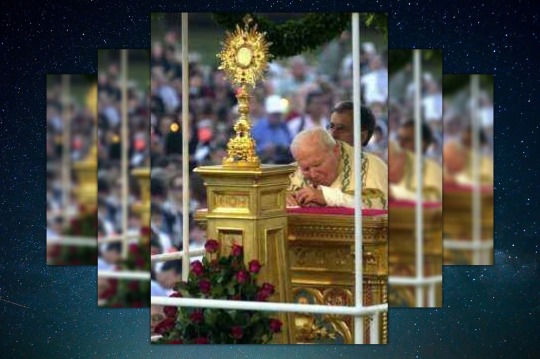
View On WordPress
0 notes
Text
"O sacrum convivium ..."czyli ogień Boga albo Cud cudów!
“O sacrum convivium …”czyli ogień Boga albo Cud cudów!
Opis ustanowienia Eucharystii w Ewangeliach synoptycznych porusza prostotą i « dostojnością », z jaką Jezus w wieczór Ostatniej Wieczerzy ustanawia ten wielki Sakrament. Istnieje pewien epizod, który w pewnym sensie jest preludium: namaszczenie w Betanii. Pewna kobieta, utożsamiona przez Jana z Marią – siostrą Łazarza, wylewa na głowę Jezusa flakonik drogocennego olejku, wywołując wśród…

View On WordPress
0 notes
Text
Querido Padre Angelo, buenos días y feliz Domingo.
Quería preguntarle algo: mi párroco me dijo, después de haberme confesado durante dos años, que puedo comulgar no obstante el vicio solitario.
Acudí también a un psicólogo, para ententender las motivaciones de mis incesantes caídas, y mi padre espiritual me dijo que puedo y debo tomar la comunión , en vez de confesarme cada vez que caigo, porque “no puedo hacer lo que se me ocurre” y debo hacer lo que me dice.
Me dijo que de esta manera me privo de la comunión, acto común, porque Cristo dice “Tomen y coman”, y no “toma”, y además me dijo que todos pecamos, que la Comunión no es el premio para los perfectos etc…
(...).
En fin, ¿debo hacer lo que me dice? Él me dice que no tengo que demonizar este asunto, porque hay otros muchos pecados peores que este. Yo comulgué en este estado, pero no lo viví bien…
Ni bien caigo, pienso que debo confesarme enseguida.
Oro por usted.
Respuesta del sacerdote
Muy querido,
1. el acto impuro es objetivamente un pecado grave.
Subjetivamente puede ser menos grave si hay razones que influyen sobre el intelecto y la voluntad al punto que el sujeto no goza de plena conciencia de la mente (no sabe lo que está haciendo y tampoco sabe que se trata de un acto grave) y no tiene dominio sobre el acto.
La plena advertencia de la mente y el deliberado consentimiento de la voluntad son las dos condiciones, que juntamente con la gravedad de la materia, hacen que un acto sea objetivamente pecado grave y haga perder esa comunión con Dios que llamamos estado de gracia.
2. Yo no quiero mínimamente juzgar tu responsabilidad subjetiva porque no te conozco ni estamos ante una confesión sacramental.
Me limito tan sólo a considerar las motivaciones que mencionó tu párroco, motivaciones -dices que de hecho no te satisfacieron. Y justamente, lo cual te honra.
Aclarado esto, puede ser que en ti subsistan motivaciones reales, que tal vez el párroco no te ha querido revelar, que convierten el acto menos grave de lo que objetivamente es.
Las que ha manifestado en cambio son insuficientes.
3. La primera motivación señalada acerca del hecho que nuestro Señor dijo: “Tomen y coman todos”, en plural. Queriendo decir de esta manera que se trata de un acto comunitario.
Es cierto que la Eucaristía no es un acto puramente individual, sino un acto cumplido en comunión con Cristo y con la Iglesia.
Sin embargo, si alguien ha interrumpido su relación con Cristo y la Iglesia, primero debe reconciliarse.
Lo dijo Nuestro Señor por boca de Pablo con un texto muy importante: “Por eso, el que coma el pan o beba la copa del Señor indignamente tendrá que dar cuenta del Cuerpo y de la Sangre del Señor. Que cada uno se examine a sí mismo antes de comer este pan y beber esta copa; porque si come y bebe sin discernir el Cuerpo del Señor, come y bebe su propia condenación”(1 Cor 11,27-30).
También en la primera comunidad cristiana de Corinto habían desórdenes y la comunión eclesial estaba rota.
Pero justamente por esto Dios dijo por boca de San Pablo que es necesario antes examinarse a sí mismos, hacer lo que debe hacerse es decir reconciliarse, y después comer del Cuerpo y de la Sangre del Señor.
De otro modo comulgar sería solo ficción, porque de hecho no existiría comunión.
Con la consecuencia que, profanando el sacramento, se comería y bebería la propia condenación.
4. Por esto Juan Pablo II en la encíclica Ecclesia de Eucharistia dijo: “La integridad de los vínculos invisibles es un deber moral bien preciso del cristiano que quiera participar plenamente en la Eucaristía comulgando el cuerpo y la sangre de Cristo. El mismo Apóstol llama la atención sobre este deber con la advertencia: « Examínese, pues, cada cual, y coma así el pan y beba de la copa » (1 Co 11, 28). San Juan Crisóstomo, con la fuerza de su elocuencia, exhortaba a los fieles: «También yo alzo la voz, suplico, ruego y exhorto encarecidamente a no sentarse a esta sagrada Mesa con una conciencia manchada y c
orrompida. Hacer esto, en efecto, nunca jamás podrá llamarse comunión, por más que toquemos mil veces el cuerpo del Señor, sino condena, tormento y mayor castigo».
Precisamente en este sentido, el CIC (n. 1385) establece: «Quien tiene conciencia de estar en pecado grave debe recibir el sacramento de la Reconciliación antes de acercarse a comulgar». Deseo, por tanto, reiterar que está vigente, y lo estará siempre en la Iglesia, la norma con la cual el Concilio de Trento ha concretado la severa exhortación del apóstol Pablo, al afirmar que, para recibir dignamente la Eucaristía, «debe preceder la confesión de los pecados, cuando uno es consciente de pecado mortal» (EE36).
5. Tu párroco dijo: “todos pecamos”. Esto es cierto por lo menos en cuanto a los pecados veniales, pero no es cierto que todos cometen pecados mortales o viven en pecado mortal.
De todas formas, ante un pecado mortal antes de comulgar, hay que confesarse.
San Agustín diría: ¿por qué Jesús instituyó el sacramento de la confesión? He aquí sus textuales palabras: “Entonces, ¿se dijo inútilmente: Lo que desatéis en la tierra será desatado en el cielo? Entonces, ¿se confiaron sin valor alguno las llaves a la Iglesia? ¿Esquivo el Evangelio y las palabras de Cristo”? (Sermón 392, 3).
No es suficiente decir “todos pecamos” para sostener que no es necesaria la confesión.
6. Y al final dijo que “la Comunión no es el premio para los perfectos etc…”.
Sí, es cierto, la comunión no es el premio para los perfectos porque de otro modo ninguno de nosotros podría comulgar.
Sin embargo para tomar la Santa Comunión, que es un sacramento que hace crecer la vida de la gracia (por eso en un canto eucarístico se dice “Tú del débil eres vigor”), debe suponer la presencia de la gracia.
Si la gracia no está, hay que recuperarla.
Ahora bien, el sacramento que Cristo instituyó para recuperar la gracia no es el de la eucaristía, sino el de la confesión sacramental.
Con ello será siempre verdad el hecho que si alguien comulga en pecado mortal comete un sacrilegio. Es solamente una comunión ritual, y no una verdadera comunión.
7. Esto es todo lo que me ha parecido necesario decirte.
Repito: puede ser que el párroco tenga otras motivaciones y sea oportuno que te atengas a lo que te dice.
Sin embargo, las motivaciones que me has presentado, no son suficientes.
Mientras te agradezco de corazón por la oración que me has ofrecido, te deseo todo bien, te garantizo la mía y te bendigo.
Padre Angelo
0 notes
Quote
At the dawn of this third millennium, we, the children of the Church, are called to undertake with renewed enthusiasm the journey of Christian living. As I wrote in my Apostolic Letter Novo Millennio Ineunte, “it is not a matter of inventing a 'new programme'. The programme already exists: it is the plan found in the Gospel and in the living Tradition; it is the same as ever. Ultimately, it has its centre in Christ himself, who is to be known, loved and imitated, so that in him we may live the life of the Trinity, and with him transform history until its fulfilment in the heavenly Jerusalem”. The implementation of this programme of a renewed impetus in Christian living passes through the Eucharist.
Every commitment to holiness, every activity aimed at carrying out the Church's mission, every work of pastoral planning, must draw the strength it needs from the Eucharistic mystery and in turn be directed to that mystery as its culmination. In the Eucharist we have Jesus, we have his redemptive sacrifice, we have his resurrection, we have the gift of the Holy Spirit, we have adoration, obedience and love of the Father. Were we to disregard the Eucharist, how could we overcome our own deficiency?
Pope John Paul II, Ecclesia de Eucharistia, no. 60.
2 notes
·
View notes
Link
0 notes